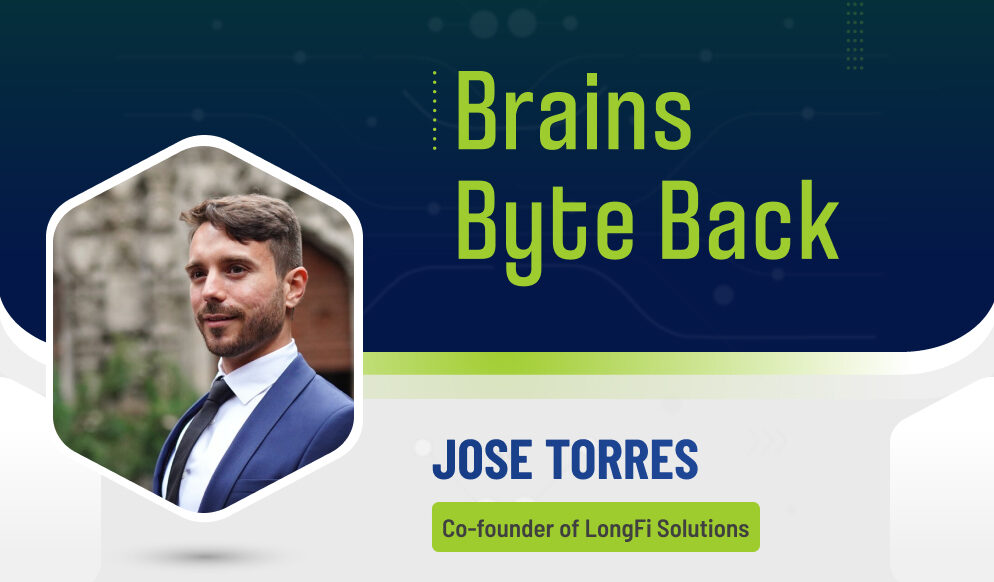In today’s episode of the Brains Byte Back podcast, we speak with Jose Torres, co-founder of LongFi Solutions, a company that deploys Decentralized Infrastructure to enable low-cost, last-mile connectivity essential for local communities.
Torres kicks off today’s show by sharing his background, including his journey from Medellin, Colombia, to the United States and his experience in aerospace engineering and the water desalination industry.
Torres also shares how the name “LongFi” originated from a protocol created as part of the decentralized wireless movement, adding that a focus on IoT led to the name “LongFi Solutions.”.
Additionally, Torres educates listeners about the DeWi (Decentralized Wireless) ecosystem, and how it is leveraging blockchain and crypto tech stack for innovative wireless communication network deployment.
On this topic, he opens up about the limitations of the conventional telecommunications business model, such as high capital costs, limited profitability, coordination challenges, and slow expansion.
He then details how the role of the blockchain and crypto tech stack can help overcome these challenges and enable disruptive and innovative ways to deploy wireless communications networks. This is then followed by examples of functioning DeWi ecosystems and blockchains, showcasing the potential of this new sector.
Before wrapping up the show, Torres shares the philosophy behind decentralization and the belief in eliminating the wall between the controlling elite and the rest of the world.
He speaks about leveraging blockchain and crypto tech stack to create a unified ecosystem where individuals can participate in the improvement and share the profits, and he also stresses the need for cryptocurrencies and blockchains as a unifying layer in the decentralized wireless ecosystem.
And finally, Torres highlights the example of the Helium network, where antenna owners receive micropayments in real-time to provide connectivity to IoT devices, and elaborates on how cryptocurrencies enable seamless micropayments for data transmission between antenna owners, sensor owners, and end users.
You can listen to the episode below, or on Spotify, Anchor, Apple Podcasts, Breaker, Google Podcasts, Overcast, Listen Notes, PodBean, and Radio Public.
Alternatively, you can find a transcript below:
Jose Torres: First of all, thank you for having me. I’m super excited to be here. So my name is Jose Torres. I was born in Medellin, Colombia, and I moved to the States to Miami with my family when I was about 10 years old. I then completed a degree in aerospace engineering and worked in the oil and gas industry for about four years. At that time, I went back to get a master’s degree in mechanical engineering and then started working for a water desalination company for about three years. I learned that water desalination is pretty much COVID-proof, recession-proof, so it’s a really good industry to study.
From an investment standpoint, it was around that time that I was first introduced to Bitcoin, and that completely blew my mind as an intellectual topic. It became sort of my favorite intellectual topic, and that’s what started my drive to think outside of the corporate world and focus all my attention on decentralized blockchain power ecosystems, which we’ll discuss in a little bit. Today, I am a co-founder at LongFi Solutions, where we focus on creating more reliable and accessible connectivity through the deployment of decentralized wireless infrastructure or DeWi infrastructure, which are essentially antennas or radios that provide 4G and 5G communication networks.
Samuel Brake Guia: Thank you so much for joining me today because I don’t think we’ve covered this topic on the show before. At least I don’t have any knowledge of it, and I’m not sure if my listeners do. So I’m really excited to get into this and learn something new. Before we do get into it, I want to know when and how LongFi Solutions first started?
Jose Torres: Yeah, that’s the origin story. So, around 2019, a San Francisco-based company called Helium released the first DeWi or Decentralized Wireless Ecosystem. In a nutshell, it motivates individual entities to deploy small antennas that earn cryptocurrency by providing connectivity in the Internet of Things (IoT) realm to their surrounding communities. One of their first launch sites was Austin, and Josh Heller, the founder and CEO of LongFi Solutions, got into this space. He attended one of their first events and purchased one of these hotspots or helium antennas. He quickly realized the huge potential in this technology, so he started purchasing more and more hotspots and deploying them at friends’ and families’ places.
Soon, it continued to grow, and he partnered with Andrew, the other co-founder. The operations grew quickly, and that’s when they formally incorporated LongFi Solutions. I met Andrew while playing beach volleyball, which is probably my favorite pastime. We started casually talking about cryptocurrency and realized that we were both into Helium. Just like Bitcoin, Helium blew my mind, and I started learning more about it.
It turned out that LongFi Solutions had an interest in deploying helium infrastructure in Colombia, South America, and I also had that interest. However, I didn’t have the right equipment for it because Colombia operates at a different frequency. All my equipment was meant for the US, but LongFi Solutions had the right equipment, although they lacked the local knowledge and business development contacts for a deployment. So, I partnered up with LongFi Solutions and proposed doing a pilot project in Medellin. We flew down there, and in just three days, we deployed about 10 hotspots in Medellin, which had the perfect topography for it. The city is surrounded by mountains, which provide a perfect panoramic view for spreading out connectivity.
So, that deployment campaign went, excellent. Then I came back to my daytime job with this water desalination company. At the time, I was an engineering manager for the research and development sector, and I was pretty happy when I got a phone call from Andrew. He said, “Hey, man, let’s go out, have lunch. We want to talk to you.” And he said, “We really loved what we did in Medellin. We want you to help us do the same thing but in all of South America.” I had been thinking about exiting the corporate world for a while. I had been flirting with the idea of moving back to South America, and I definitely wanted to move into the decentralized and cryptocurrency landscape. So for me, it was the perfect opportunity. Without much deliberation, I said, “Alright, let’s pivot.” And it happened roughly a bit more than a year ago, in March of 2022. So that’s how LongFi Solutions started. It started with Andrew and Josh as a hobby, but then it quickly grew into what we are today, which is an international operations telecommunications company.
Samuel Brake Guia: Congratulations on all this success. It’s wonderful to see that your passion aligns with what you’ve been able to do. That’s really nice to see. And it’s also great to speak with someone who is actually involved here in Medellin. It’s so nice to see that you’re actually here so often. I usually speak with people in the US or other parts of the world. So it’s a real rarity to have someone here that is working basically in my backyard. Yeah, and I want to know, what is the story behind the name LongFi Solutions?
Jose Torres: Right. So LongFi is actually the name of a protocol, a communications protocol, that the San Francisco company started as part of the decentralized wireless movement. They created a protocol that combines an existing protocol called LoRaWAN, which stands for Long Range Wide Area Network. It’s a telecommunications protocol for the Internet of Things (IoT). It’s used for devices like sensors, temperature sensors, and any type of sensor that needs to communicate over long distances but only needs to send very low bandwidth data. This is the protocol they use. Helium took the LoRaWAN protocol and integrated it into the Helium blockchain ecosystem. So when these devices communicate with each other, they go through a blockchain, specifically the Helium blockchain. LongFi came out of the combination of LoRaWAN and Wi-Fi, or just Wi-Fi for fun. When the team learned about it, they said, “Okay, we’re going to focus on IoT, so LongFi Solutions.” That’s where the name came from. Today, our company has grown far beyond the IoT protocol, but the name has a nice ring to it. We call the company LongFi for short, and it has grown on us. So that’s the origin story of the name.
Samuel Brake Guia: I like it. Maybe I’m a bit biased because I love listening to lo-fi music when I study. But it’s really nice. I also want to know, with LongFi Solutions, I’ve seen on the blog that you have many posts talking about the DeWi ecosystem. In one of them, you mentioned the DeWi blockchains. You’ve kind of spoken about this a little bit already on the show, but can you explain what the DeWi ecosystem is? And also, what the DeWi blockchains are?
Jose Torres: Absolutely. This is where we really get into the differentiating factor of what’s going on here in this new movement, which makes it really unique and interesting from a telecommunications and connectivity standpoint. So, in short, DeWi is an exciting new sector that leverages tools from the blockchain and crypto tech stack to enable disruptive and innovative ways to deploy wireless communications networks.
Now, to capture and understand the value of this new sector and why it’s important, I’d like to talk about four topics. First, it’s good to understand how the conventional telecommunications business model works and how the deployment works. So, where we are without DeWi Then I’d like to mention a few limitations of the current business model because this serves as the motivation to do something different. What are the limitations of the conventional traditional model in meeting the growing connectivity needs of humanity around the world? And once we understand that, we can say, ok, how does this blockchain or crypto tech stack help in overcoming these challenges? And this is where DeWi comes in. Finally, I’d like to give some examples of where the DeWi ecosystem is and what are the actual ecosystems or blockchains that are functioning. So, let’s start with the first part, which is forgetting about this current technology. How are we doing things now?
In the telecommunications world, especially with 3G, 4G, and 5G, they work in a very centralized fashion and behind closed doors. I like to think about it as dividing the world into two parts. On one side, we have the elite class, the high-dollar investors, and the people who have control over the means of deploying, creating, and innovating. They are in their own little world, investing, deploying, maintaining, selling, and profiting. On the other side of the wall, we have the consumer class, who are never invited to take part in the innovation, deployment, or profit of new technology.
Now let’s move on to the second part, which is what’s wrong with the current business model and how can we meet the world’s growing connectivity needs? The first limitation is that deploying telecommunication equipment requires a massive amount of capital, especially in a centralized way. Think about companies like AT&T, T-Mobile, Verizon, or in Colombia, we have Claro and Movistar. All these companies have high overhead costs per installation or deployment. It’s an expensive operation for these big companies, and it limits deployments to only profitable areas. Unfortunately, many non-profitable areas are left behind in terms of technology because it’s not profitable for companies to deploy everywhere. They’re limited in range due to high capital costs and the need to meet profit margins.
There’s also a high degree of coordination needed across wide geographies and jurisdictions that centralized companies need to abide by. This limits the speed of expansion. Even within the United States, companies like AT&T face different requirements for different states and cities, making their expansion slow. International expansion brings additional limitations in terms of regulations and taxes. Profitability is also limited due to these factors.
One of the main drivers for the decentralized approach is the transition to 5G. Everyone wants 5G, right? So let’s talk about that transition from 4G or LTE (Long-Term Evolution), which technically doesn’t mean anything. It was like 4G Plus. We’ve been in 4G+ for the past 7 to 10 years. When we transition to 5G, it’s because 5G can carry more data and is much faster, about an order of magnitude faster than 4G.
However, this does not come for free. There’s always an engineering trade-off. Yes, 5G is about 10 times faster compared to 4G, but the range of 5G is about 5 to 10 times lower than 4G. So if a typical 4G signal covers a two-mile radius, a 5G signal can cover five to ten times less than that. This brings about a monumental challenge for the telecommunications industry. For example, let’s say AT&T has 100 4G radios to cover the city of Miami. If they want to provide 5G coverage, they would need to increase their radio deployment density by 5x or 10x. That means they would need 500 to 1,000 radios to provide coverage. 5G radios require a larger quantity and more strategic placement because they don’t penetrate walls as well as 4G. This creates a huge operational and business challenge for the big telecom industries, as their deployment costs on a unit basis are very high.
So those are some of the limitations of the current business model. Now, let’s think about the tools we have at our disposal to overcome these challenges. At the heart of the decentralized approach is the belief that we can and should eliminate the wall between the controlling elite or the innovation class and the rest of the world. Decentralization aims to spread innovation at the edge. The decentralized wireless ecosystem invites every individual to participate in the improvement of the entire system and to take a share of the profits proportional to their individual contribution. From a philosophical standpoint, this makes a lot of sense because we’re leveraging anyone who has the passion, knowledge, and a little bit of capital and time to contribute to a more efficient ecosystem compared to the centralized approach.
In this case, cryptocurrencies or blockchains are needed as a unifying layer that makes this ecosystem work as one single organism composed of many individual entities. Let me give you an example of how we couldn’t do this with conventional financial tools. Whenever I learn about a new crypto or blockchain project, one of the first questions I ask is, “Can we do it without blockchain?” If the answer is yes, then I’m not a fan of using blockchain just for the sake of it. I believe that if we can achieve things without unnecessary complexity and cutting-edge technology, we should. But let me give you an example of how the decentralized wireless ecosystem needs and leverages cryptocurrency.
In the Helium ecosystem, each antenna owner receives a micropayment in real-time for each time an individual end user uses the service. For instance, if we both have Helium antennas on our balconies in Medellin and there’s a person who owns a taxi fleet, let’s say they have 20 taxis operating and each taxi has sensors connected to the Helium network in the IoT sector, such as velocity GPS or oil temperature. Each time one of these taxis passes by our antennas, the antenna owner receives a micropayment from the taxi owner for the data transmitted. The taxi owner and you, as the owner of the antenna, receive the data.
The taxi continues going around the city and when it passes by my antenna, the same process repeats. Each time it uses the service of an antenna, it automatically provides a micropayment in real-time, and then the data is transferred to the sensor owner.
This means that in a single day, your antenna could facilitate data transfers from hundreds or thousands of different users, with each micropayment being less than one cent. Now, if you take this business idea to a bank like MasterCard in Colombia and explain that you plan on making thousands of transactions per day, they might offer you a seat and ask what you’d like to drink. However, when you mention that each payment is less than one cent, they will find it strange. They know that each payment through the system costs them about five to ten cents.
Additionally, if you mention that many of those users are not registered in the financial system and don’t have bank accounts or Social Security numbers, they may reject your proposal. This example highlights how the current financial payment system cannot handle the imagination of streaming money as if it were data, with micro-payments and payments to entities without the burden of registering all users with a bank account.
That’s just one example of how decentralized wireless systems necessitate a new type of payment technology, brought about by cryptocurrencies and blockchain technologies.
Now, let me share a little bit about the current state of the DeWI ecosystems or DeWi blockchains that are currently active and functioning.
First, we have the Helium network, which was launched in 2019. In less than three years, this network became the largest continuous IoT network in history, with close to one million deployments in over 170 countries. When you think about that, no company has achieved this in a centralized fashion. No company has operated at this scale or provided such widespread IoT coverage in such a short time. This is a proof of concept that through the right incentives and ecosystem, we can motivate individuals worldwide to take action in the physical world, deploy hotspots on their rooftops or balconies, and ensure their proper functioning. They are motivated by the monetary incentives and the connectivity they provide to their communities.
Companies like Helium and Xnet have proven this concept, and now they are thinking about leveraging the same incentivized monetary and cryptocurrency system for 5G networks across the US. The goal is to bring individuals together into a collective organism that works to create a widespread and efficient telecommunication infrastructure. LongFi Solutions plays a key role in this effort as an infrastructure deployer. We purchase the antennas, find the best locations to deploy them, and complete the installation process. We handle the entire business cycle, from customer acquisition to keeping the antennas operational and ensuring good service to the community. We also provide payment to the hosts. If you own several properties or know someone who does, we would be interested in discussing the deployment of antennas to provide better connectivity to users and offer passive income by utilizing a portion of your roof or balcony. That’s an overview of what the DeWi ecosystem means, why it’s important, and the problems we are solving in this new sector.
Samuel Brake Guia: In this market, are you the only ones doing this, or are there other companies operating in this space who are disrupting things and breaking new ground? And if there are others, how do you differentiate yourself from the competition?
Jose Torres: Absolutely. I’d like to expand on that question. First, let’s talk about the relationship between the two big industries: the incumbents like AT&T, Claro, and other major telco companies, and the decentralized wireless companies or movement, such as Helium and Xnet. Currently, their interplay is very complementary, and they are not in direct competition with one another.
For the incumbents like AT&T, their biggest challenge is customer retention. When users experience poor signal or service, they consider switching to other providers, and sometimes the competitors even offer to pay for cancellation fees or provide better plans. The high turnover is a significant problem for these companies. So the last thing they want is for their users to have an unreliable and weak connection when they are out and about. This problem will become even more pronounced when we transition from 4G to 5G because these companies do not have the resources to densify their cities with 5G deployments.
This is where the DeWi movement comes in with a proposal. Helium and T-Mobile already have a partnership that is quite complementary. Helium introduces a Helium phone plan, becoming the first crypto carrier. When Helium users are within range of a Helium 5G antenna, they will use that antenna, and the owner of the 5G antenna will get paid based on usage. But when there is no Helium 5G antenna within range, the user will seamlessly switch to a T-Mobile antenna. In the beginning, Helium brings users to the T-Mobile infrastructure because there are not many Helium deployments yet. However, over time, the expectation is that the decentralized approach will densify much faster than the centralized approach. When a T-Mobile user is not within range of a T-Mobile radio but is within range of a Helium 5G radio, T-Mobile will ask Helium to provide the service to their users seamlessly. T-Mobile wants its users to have connectivity, even if it’s not through their own infrastructure.
So, currently, the two ecosystems are complementing each other, and this dynamic is expected to continue for the next four to six years. Eventually, as the space becomes filled up, competition will emerge, and it will be interesting to see how the decentralized approach competes with the centralized approach. That’s the player arrangement or game theory at the highest level for the next few years. Now, if we focus on the decentralized ecosystem entirely and consider LongFi Solutions and other companies like ours within this ecosystem, there are indeed other companies operating in this space.
The good thing here is that the space is so nascent that we have more of a collaborative or healthy competition with other companies like us. For example, we’re a Houston-based company, and we’re hyper-focused on Houston, San Antonio, Denver, and Miami. So whenever we have locations in those areas, we deploy our own equipment. But many times we get locations in Los Angeles, San Francisco, or New York, and it’s not the best for us to expand our operational footprint to those states. However, if we know companies that are doing the same thing in those states, we can partner up and say, “Hey, look, you have your teams and boots on the ground, so take these locations, and we can work out an arrangement.” The same is true when companies from other states approach us and offer locations in our areas. Currently, the competition is quite healthy, but over time, as more companies join us and grow their footprint, clashes are bound to happen. Within four to six years, we may see more competition even within the DeWi space.
What will differentiate LongFi Solutions? First of all, we have been there from the start. Our CEO, Josh, installed the first helium hotspot in the city of Houston, which is now the fourth or fifth city with the most hotspots in the world. We have developed good relationships with all the other key players in the ecosystem, including the Helium blockchain developers. We also have strong relationships with real estate owners in some cities, and we will continue to develop those strategic partnerships. We have the technical expertise, operational knowledge, recent funding, and the real estate assets necessary for our infrastructure deployment. This well-rounded ecosystem and partnerships from hardware to real estate are what will differentiate us in the long run. We aim to be the partner of choice for the best locations in the cities we focus on.
Samuel Brake Guia: I think it’s awesome that you’re able to partner and collaborate. That’s fantastic to see. I’ve really enjoyed this conversation. We have come to the end of our time. But before we go, I would love to know, Jose, if people want to keep up with the work that you’re doing, what’s the best place for them to go? Where would you recommend they follow?
Jose Torres: Absolutely. We’re quite active on our CEO Josh’s Twitter account, where he posts a lot about what we’re doing. We also have our website, longfisolutions.com, where we provide a brief explanation of what we do and how we do it. Especially if your audience is in one of the cities we focus on and wondering how they can participate and contribute, they can reach out via the website or shoot me an email at [email protected]. We are actively looking to expand the network and create a business model that benefits everyone involved in creating better and more accessible connectivity for communities.












